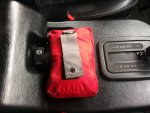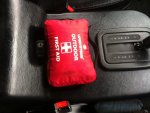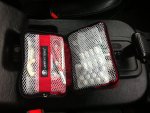I use a orange 1550 pelican case stuffed full of crap bought individually. Put a big reflective Red Cross on it and consider myself ready to go. I went with the regular box and not the fancy EMS version with the organizer due to the extra cost.
Most pre packaged kits have too much stuff that you don't need and do not have some of the big ticket items you do need.
Totally agree. That's what I use on the Fire Truck as well, a Pelican 1550 set up with pretty much everything I need for 1-2 patients in most situations. You can even slip a spinal collar in a 1550 diagonally if you are careful when you close it. Ours is bright yellow because our truck is set up color coded, so I can tell someone what to bring by color (Yellow is the first-on-scene bag, Orange is O2, Green is C-spine, Red is spares and refills). It's easy to say "bring me the back-board and the green bag".
I can't count how many times that kit has bounced down a driveway, a set of stairs, or into the muddy ditch beside the highway (usually in the hands of a firefighter who has lost his footing in the snow trying to climb down to the accident scene). But every time I open it, everything is intact, dry, clean, in its proper place, and good to go.
I like the way it opens and stays open, and the fact that it's packed as a single-layer kit, which means it's a lot easier to have beside me when I am kneeling next to a patient, I can just grab what I need between two fingers and lift it out of the kit, rather than having to rummage through a canvas bag, especially once my gloves are contaminated.
This is important for a truck-kit, because sometimes I am working alone on a patient and don't always have a helper to grab stuff from the bag, or even if I do it's easier to just grab what you need from the bag than to try to explain to your helper what you need. Also I can open it in the snow or mud and not worry about the contents getting dirty as I am working.
One thing I notice is that most people set up their kits with a TON of bandages and dressings of different types and sizes and very little other stuff. Remember a gloved hand and pressure will manage the bleeding until the calvary shows up. If you start running low on space in your kit, I'd bring a few less bandages, and leave room for a set of airways, a collapsable BVM if you regularly travel with someone who also knows cpr, a pocket mask for when you are alone, and a suction pump (the kind you squeeze with your hand, like the V-Vac, which is good because it's flat so it will fit in the kit, see
http://www.lifemedicalsupplier.com/vvac-starter-kit-manual-suction-pump-p-1042.html). You can use SAM splints as section dividers in your kit so that also saves a lot of space. Keep a ballpoint and a couple of Sharpies taped to the inside of the lid, next to your small flashlight. And keep a small head-torch in the kit too, you don't want to be holding a flashlight in your teeth once your gloves are contaminated.
When we respond to MVAs on the highway (which is the most probable worst-case use for carrying a full kit in your truck) we use that stuff (and blankets) as much as dressings. As far as dressings go, if you want to make life easy, just get 1 type, a bunch of big, non-stick dressings. You can use them anywhere you need to (burns, road-rash etc) and if they are too big, well that's what the scissors are for. Yes non-stick are more expensive than regular dressings, but when you need them and you are trying to remember which is which, you won't care about the extra cost. Oh, and have medical tape in different thicknesses. I like the 3M Micropore, (the paper type). It's breathable, sticky but not too sticky, strong enough to use as a butterfly, and easy to tear to length so you don't need to use your scissors all the time with it.
And of course as has been said, get trained on how to properly use all that stuff.
Oh, and I should mention, these suggestions are for a bag that is set up for general First Response calls, and MVAs. How you would prep a Wilderness First Aid bag would be a bit different. In that case you may not have the Life Flight only 20 mins away, so you might actually need all those extra bandages as well as a bunch of other stuff. I would never recommend taking a Pelican case on a hike, but for a case that can live inside your truck and provide what you need if you are first on scene at an MVA, I think something like a Pelican 1550 is the way to go.







